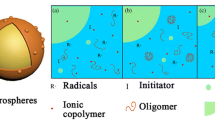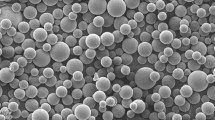Abstract
Polystyrene (PS) UV absorber microspheres of narrow size distribution have been prepared in two ways: (1) Entrapment of the UV absorber molecule, 2-(5-chloro-2H-benzotriazole-2-yl)-6-(1, 1-dimethylethyl)-4-methyl-phenol) [TINUVIN® 326] within uniform PS template microspheres by swelling these template particles with methylene chloride emulsion droplets containing the TINUVIN, followed by evaporation of the methylene chloride from the swollen PS microspheres. (2) A similar swelling process, substituting the methylene chloride emulsion droplets containing the TINUVIN for methylene chloride emulsion droplets containing the monomers, divinyl benzene (DVB) and styrene (S) and the initiator, benzoyl peroxide and TINUVIN. The monomers within the swollen microspheres were then polymerized by elevating the temperature of the swollen particles to 73 °C. The influence of the weight ratio [TINUVIN]/[PS] on the entrapped percentage of TINUVIN was elucidated. Polyethylene/TINUVIN, PE/(PS/TINUVIN), and PE/(PS/P(S-DVB-TINUVIN)) resins and films were prepared by melt blending of low-density PE with TINUVIN and with the UV absorber microspheres, followed by a tubular blown process. The UV absorption of these composite films was demonstrated. The leakage kinetics of the TINUVIN from these composite films was according to the following order: PE/(PS/P(S-DVB-TINUVIN)) < PE/(PS/TINUVIN) < PE/TINUVIN.

Polystyrene (PS) UV absorber microspheres of narrow size distribution have been prepared in two ways: (1) Entrapment of the UV absorber molecule, 2-(5-chloro-2H-benzotriazole-2-yl)-6-(1, 1-dimethylethyl)-4-methyl-phenol) [TINUVIN® 326] within uniform PS template microspheres by swelling these template particles with methylene chloride emulsion droplets containing the TINUVIN, followed by evaporation of the methylene chloride from the swollen PS microspheres. (2) A similar swelling process, substituting the methylene chloride emulsion droplets containing the TINUVIN for methylene chloride emulsion droplets containing the monomers, divinyl benzene (DVB) and styrene (S) and the initiator, benzoyl peroxide and TINUVIN. The monomers within the swollen microspheres were then polymerized by elevating the temperature of the swollen particles to 73 °C. Polyethylene/TINUVIN, PE/(PS/TINUVIN) and PE/(PS/P(S-DVB-TINUVIN)) resins and films were prepared by melt blending of low density PE with TINUVIN and with the UV absorber microspheres, followed by a tubular blown process. The UV absorption and leakage kinetics of these composite films was demonstrated.









Similar content being viewed by others
References
Galdi A, Foltis P, Shah A (2010) UV protecting composition and methods of use. Application: US patent 2010–118415
Pospisil J, Pilar J, Billingham NC, Marek A, Horak Z, Nespurek S (2006) Factors affecting accelerated testing of polymer photostability. Polym Degrad Stab 91:417–422
Bojinov VB, Grabchev IK (2005) Novel functionalized 2-(2-hydroxyphenyl)-benzotriazole-benzo[de]isoquinoline-1,3-dione fluorescent UV absorbers: Synthesis and photostabilizing efficiency. Polym Photochem Photobiol 172:308–315
Gugumus F (1990) Light stabilizers. In: Gächter R, Müller H (eds) Plastic additives handbook, 3rd edn. Hanser, Munich, Viena, New York, pp 129–271
Bojinov V (2006) Synergistic efficiency of combined HALS–UV absorber polymerizable stabilizers. J Appl Polym Sci 102:2408–2415
Parejo PG, Zayat M, Levy DJ (2006) Highly efficient UV-absorbing thin-film coatings for protection of organic materials against photodegradation. Mater Chem 16:2165–2169
So YH (2006) Photodegradation mechanism and stabilization of polyphenylene oxide and rigid-rod polymers. Polym Int 55:127–138
Crawford JC (1999) 2(2-hydroxyphenyl)2H-benzotriazole ultraviolet stabilizers. Prog Polym Sci 24:7–43
Goldshtein J, Margel S (2009) Synthesis and characterization of new UV absorbing microspheres of narrow size distribution by dispersion polymerization of 2-(2′-hydroxy-5′-methacryloxyethylphenyl)-2H-benzotriazole. Polymer 50:3422–3430
Bojinov VB, Simeonov DB (2006) Synthesis of novel bifunctional polymer stabilizers—A combination of HALS and UV absorber. Photochem Photobiol A Chem 180:205–212
Chen TJ (1980) Processes for achieving uniform efficient distribution of hydrophobic materials through hydrophilic colloid layers and loaded latex compositions. Application: US patent 1980–4199363
Ugelstad J (1978) Swelling capacity of aqueous dispersions of oligomer and polymer substances and mixtures thereof. Makromol Chem 179:815–817
Ugelstad J, Mork PC, Nordhuus I, Mfutakamba H, Soleimany E (1985) Thermodynamics of swelling. Preparation and application of some composite, monosized polymer particles. Macromol Chem Suppl 10(11):215–234
Cheng CM, Micale FJ, Vanderhoff JW, El-Aasser MS (1992) Synthesis and characterization of monodisperse porous polymer particles. J Polym Sci Part A Polym Chem 30:235–244
Hosoya K, Frechet JMJ (1993) Influence of the seed polymer on the chromatographic properties of size monodisperse polymeric separation media prepared by a multi-step swelling and polymerization method. J Polym Sci Part A Polym Chem 31:2129–2141
Smigol V, Svec F, Hosoya K, Wang Q, Frechet JM (1992) Monodisperse polymer beads as packing material for high-performance liquid chromatography. Synthesis and properties of monidisperse polystyrene and poly(methacrylate) latex seeds. J Angew Makromol Chem 195:151–164
Smigol V, Svec F (1992) Synthesis and properties of uniform beads based on macroporous copolymer glycidyl methacrylate–ethylene dimethacrylate: A way to improve separation media for HPLC. J Appl Polym Sci 46:1439–1448
Liang YC, Svec F, Frechet JMJ (1997) Preparation and functionalization of reactive monodisperse macroporous poly(chloromethylstyrene-co-styrene-co-divinylbenzene) beads by a staged templated suspension polymerization. J Polym Sci Part A Polym Chem 35:2631–2643
Okubo M, Ise E, Yamashita T (1999) Synthesis of greater than 10-μm-sized, monodispersed polymer particles by one-step seeded polymerization for highly monomer-swollen polymer particles prepared utilizing the dynamic swelling method. J Appl Polym Sci 74:278–285
Okubo M, Shiozaki M (1993) Production of micron-size monodisperse polymer particles by seeded polymerization utilizing dynamic swelling method with cooling process. Polym Int 30(4):469–474
Baruch-Sharon S, Margel S (2008) Synthesis by a single-step swelling process and characterization of micrometer-sized polychloromethylstyrene/poly(butyl methacrylate) hemispherical composite particles of narrow size distribution. J Appl Polym Sci 108(6):3727–3737
Omer-Mizrahi M, Margel S (2007) Synthesis and characterization of spherical and hemispherical polyepoxide micrometer-sized particles of narrow size distribution by a single-step swelling of uniform polystyrene template microspheres with glycidyl methacrylate. J Polym Sci Part A Polym Chem 45(20):4612–4622
Galperin A, Margel S (2006) Synthesis and characterization of new micrometer-sized radiopaque polymeric particles of narrow size distribution by a single-step swelling of uniform polystyrene template microspheres for X-ray imaging applications. Biomacromolecules 7:2650–2660
Medina DD, Goldshtein J, Margel S, Mastai Y (2007) Enantioselective crystallization on chiral polymeric microspheres. Adv Funct Mater 17:944–950
Achmon Y, Goldshtein J, Margel S, Fishman A (2011) Hydrophobic microspheres for in-situ removal of 2-phenylethanol from yeast fermentation. J Microencapsulation. doi:10.3109/02652048.2011.599443
Venkatathri N, Nanjundan S (2009) Synthesis and characterization of a mesoporous silica microsphere from polystyrene. Mater Chem Phys 113:933–936
Basfar AA, Ali KMI (2006) Natural weathering test for films of various formulations of low density polyethylene (LDPE) and linear low density polyethylene (LLDPE). Polym Degrad Stab 91:437–443
Wang KH, Koo CM, Chung IJ (2003) Physical properties of polyethylene/silicate blown films. Appl Polym Sci 89:2131–2136
Decker C, Masson F, Schwalm R (2004) Physical properties of polyethylene/silicate nanocomposite blown films. Polym Degrad Stab 83:309–320
Goldshtein J, Margel S (2009) Synthesis and characterization of new flame-retardant microspheres by dispersion polymerization of pentabromobenzyl acrylate. Eur Polym J 45:2987–2995
Acknowledgments
These studies were partially supported by a Minerva Grant (Microscale and Nanoscale Particles and Films) and by The Israeli Ministry of Commerce and Industry (NFM Consortium on Nanoparticles for Industrial Applications). Thanks to Mrs. Hanna Schwartz from Kafrit Industries, Israel, for her help in the preparation of the PE/TINUVIN resins and films.
Author information
Authors and Affiliations
Corresponding author
Rights and permissions
About this article
Cite this article
Goldshtein, J., Margel, S. Synthesis and characterization of polystyrene/2-(5-chloro-2H-benzotriazole-2-yl)-6-(1,1- dimethylethyl)-4-methyl-phenol composite microspheres of narrow size distribution for UV irradiation protection. Colloid Polym Sci 289, 1863–1874 (2011). https://doi.org/10.1007/s00396-011-2505-x
Received:
Revised:
Accepted:
Published:
Issue Date:
DOI: https://doi.org/10.1007/s00396-011-2505-x




